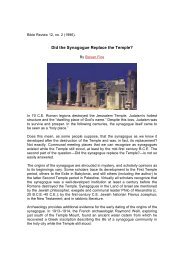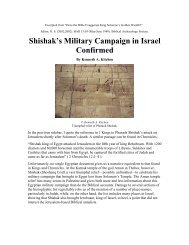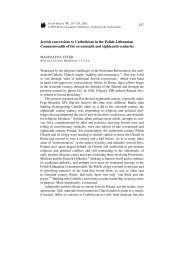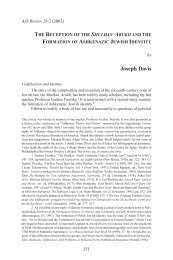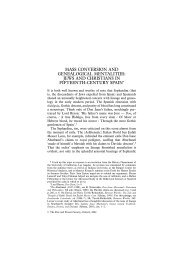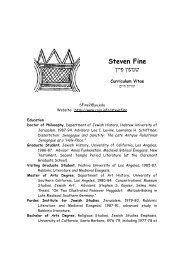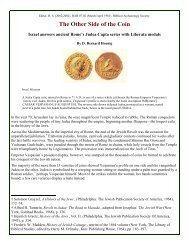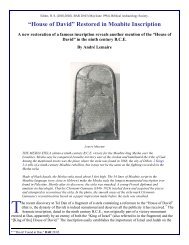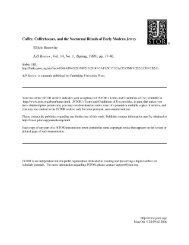3200-Year-Old Picture of Israelites Found in Egypt
3200-Year-Old Picture of Israelites Found in Egypt
3200-Year-Old Picture of Israelites Found in Egypt
You also want an ePaper? Increase the reach of your titles
YUMPU automatically turns print PDFs into web optimized ePapers that Google loves.
My work with the Epigraphic Survey had provided me with the techniques, tra<strong>in</strong><strong>in</strong>g and<br />
experience for just such a task. The pr<strong>in</strong>cipal tool <strong>in</strong> exam<strong>in</strong><strong>in</strong>g usurped cartouches is the<br />
mirror. With a mirror you rake the light across the cartouche to deepen the shadows. This<br />
makes the carv<strong>in</strong>g stand out more sharply. It is not difficult to use this technique on a<br />
stone ly<strong>in</strong>g on the ground or even on one on the lower register <strong>of</strong> the reliefs. It is more<br />
difficult stand<strong>in</strong>g on a ladder 10 feet above the ground.<br />
The technique employed by the usurp<strong>in</strong>g pharaohs—usurpation <strong>of</strong> cartouches was quite<br />
common all over ancient <strong>Egypt</strong>—was to hammer out and partly erase the orig<strong>in</strong>al name.<br />
Then the surface was coated with plaster. But <strong>of</strong>ten the erased surface would first be<br />
scored to create a roughness that would better hold the plaster. F<strong>in</strong>ally the new name<br />
would be <strong>in</strong>cised <strong>in</strong> the plaster. Over the centuries, the conceal<strong>in</strong>g plaster tends to fall<br />
away, leav<strong>in</strong>g visible traces <strong>of</strong> the carv<strong>in</strong>g beneath. In short, the very technique <strong>of</strong><br />
usurpation <strong>of</strong>ten allows the traces to be unscrambled. In many cases, the traces are clearly<br />
visible.<br />
This set <strong>of</strong> battle reliefs has dozens <strong>of</strong> usurped cartouches. But usurpation was not<br />
conf<strong>in</strong>ed to the cartouches alone; it also appears on the full extended titulary <strong>of</strong> the<br />
pharaoh <strong>in</strong> the great triumphal scene, which orig<strong>in</strong>ally was on the far right end <strong>of</strong> the<br />
wall.<br />
The names <strong>of</strong> the latest versions <strong>in</strong> these cartouches and <strong>in</strong> the titulary belonged, as I said,<br />
to Sety II. Because <strong>of</strong> the statements <strong>of</strong> earlier scholars who had seen the wall, what I<br />
expected to see beneath the upper version were the names <strong>of</strong> Ramesses II. To my<br />
surprise, when I began exam<strong>in</strong><strong>in</strong>g these cartouches closely, I discovered they had been<br />
twice usurped. The orig<strong>in</strong>al name had been partially erased; a second name had been<br />
<strong>in</strong>cised on plaster that covered the orig<strong>in</strong>al name; then that name on the plaster had been<br />
erased and replaced with the name <strong>of</strong> Sety II.<br />
Frank J. Yurco<br />
Superimposed cartouches.<br />
Draw<strong>in</strong>g <strong>of</strong> superimposed cartouches.<br />
It gradually became clear that the name below Sety II was Amenmesse (1202–1199<br />
B.C.E.), perhaps Sety’s half-brother. But below the name <strong>of</strong> Amenmesse was not the



